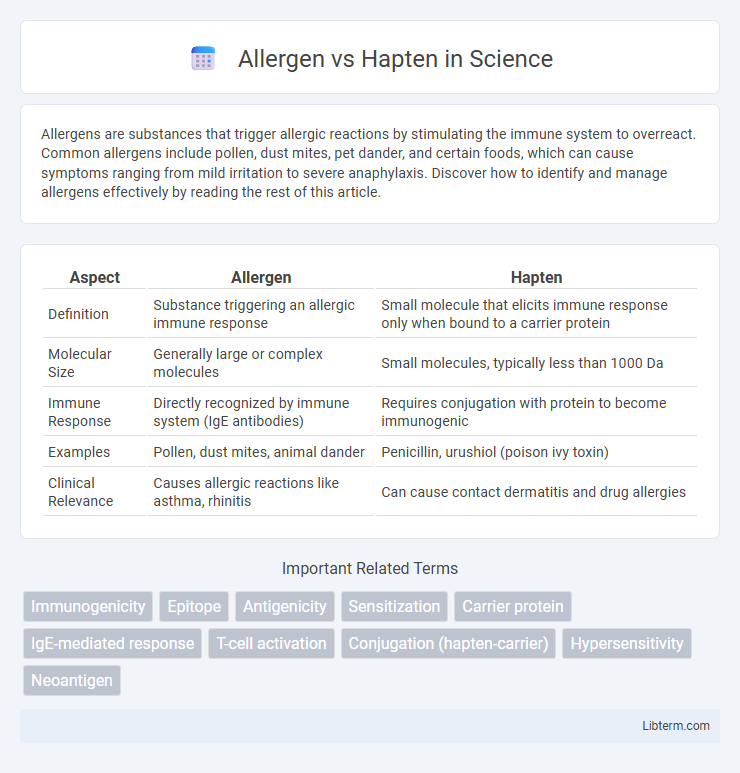Allergens are substances that trigger allergic reactions by stimulating the immune system to overreact. Common allergens include pollen, dust mites, pet dander, and certain foods, which can cause symptoms ranging from mild irritation to severe anaphylaxis. Discover how to identify and manage allergens effectively by reading the rest of this article.
Table of Comparison
| Aspect | Allergen | Hapten |
|---|---|---|
| Definition | Substance triggering an allergic immune response | Small molecule that elicits immune response only when bound to a carrier protein |
| Molecular Size | Generally large or complex molecules | Small molecules, typically less than 1000 Da |
| Immune Response | Directly recognized by immune system (IgE antibodies) | Requires conjugation with protein to become immunogenic |
| Examples | Pollen, dust mites, animal dander | Penicillin, urushiol (poison ivy toxin) |
| Clinical Relevance | Causes allergic reactions like asthma, rhinitis | Can cause contact dermatitis and drug allergies |
Introduction to Allergens and Haptens
Allergens are substances that trigger immune responses by directly interacting with the immune system, often causing allergic reactions such as asthma or hay fever. Haptens are small molecules that alone are not immunogenic but can elicit an immune response when bound to larger carrier proteins, modifying their antigenicity. Understanding the distinction between allergens and haptens is crucial for developing treatments for hypersensitivity and autoimmune disorders.
Defining Allergens: Key Characteristics
Allergens are typically proteins or glycoproteins that provoke an immune system overreaction, specifically through IgE antibody mediation, leading to allergic symptoms. They possess structural complexity and molecular weight sufficient to be recognized by the immune system as foreign, triggering histamine release and inflammation. Unlike haptens, allergens can independently stimulate an immune response without needing to bind to larger carrier molecules.
Understanding Haptens: Unique Properties
Haptens are small molecules that become antigenic only when bound to larger proteins, whereas allergens are substances that induce allergic responses independently. The unique property of haptens lies in their ability to modify self-proteins, forming new antigenic determinants recognized by the immune system. This interaction triggers immune sensitization, distinguishing haptens from typical allergens that possess inherent immunogenicity.
Mechanisms of Immune Response: Allergen vs Hapten
Allergens trigger immune responses by directly binding to IgE antibodies on mast cells and basophils, causing immediate hypersensitivity and release of histamine. Haptens are small molecules that become immunogenic only after covalently attaching to larger proteins, forming a complex that is recognized by T cells and antibodies, eliciting delayed-type hypersensitivity reactions. The immune mechanism of allergens primarily involves IgE-mediated activation, whereas haptens require antigen processing and presentation to T cells for initiating an adaptive immune response.
Molecular Structure Differences
Allergens are typically large, complex proteins or glycoproteins with molecular weights often exceeding 10,000 Daltons that can independently trigger immune responses. Haptens are small molecules, usually below 1,000 Daltons, that are immunologically inert alone but become antigenic when covalently bound to larger carrier proteins. The fundamental molecular structure difference lies in size and complexity, where allergens possess intrinsic epitopes recognized by immune cells, whereas haptens require conjugation to larger molecules to form recognizable antigenic determinants.
Sources and Examples of Allergens
Allergens are typically large, complex proteins from sources such as pollen, dust mites, pet dander, insect venom, shellfish, and certain foods like nuts and milk. Haptens, unlike allergens, are small molecules that become immunogenic only after binding to a carrier protein; examples include penicillin and some cosmetics ingredients. Common allergen sources trigger immune responses by activating IgE antibodies, while haptens require a chemical reaction to initiate sensitization.
Common Haptens and Their Origins
Common haptens such as penicillin, urushiol from poison ivy, and nickel ions originate from drugs, plants, and metals, respectively, and trigger immune responses only when bound to larger proteins. These small molecules alone are not immunogenic but become allergenic by forming hapten-carrier complexes that activate T cells and produce hypersensitivity reactions. Understanding these hapten sources is crucial in allergy diagnosis and prevention strategies targeting drug allergies, contact dermatitis, and metal hypersensitivity.
Clinical Significance: Allergy and Hypersensitivity
Allergens are substances that trigger immune responses leading to allergic reactions such as asthma, rhinitis, or anaphylaxis by directly activating IgE-mediated pathways. Haptens, although not immunogenic alone, bind to proteins forming complexes that can induce hypersensitivity reactions, notably contact dermatitis through T-cell mediated mechanisms. Understanding the distinction between allergens and haptens is critical for accurate diagnosis, management, and prevention of allergy and hypersensitivity disorders in clinical practice.
Diagnostic Methods for Allergens and Haptens
Diagnostic methods for allergens primarily include skin prick tests, specific IgE blood tests, and patch tests to identify immediate hypersensitivity reactions. Hapten diagnostics often involve patch testing to detect delayed-type hypersensitivity reactions, as haptens bind to proteins forming antigenic complexes. Advanced techniques like mass spectrometry and immunoassays help characterize hapten-protein complexes, improving identification in contact dermatitis and drug allergy evaluations.
Prevention and Management Strategies
Prevention and management strategies for allergens emphasize avoidance of known triggers, use of antihistamines, and immunotherapy to reduce hypersensitivity reactions. Hapten-related conditions require minimizing exposure to substances that bind to proteins and trigger immune responses, often managed through protective barriers and corticosteroids to control inflammation. Both approaches benefit from accurate identification of causative agents and patient education to limit exposure and mitigate symptoms effectively.
Allergen Infographic

 libterm.com
libterm.com